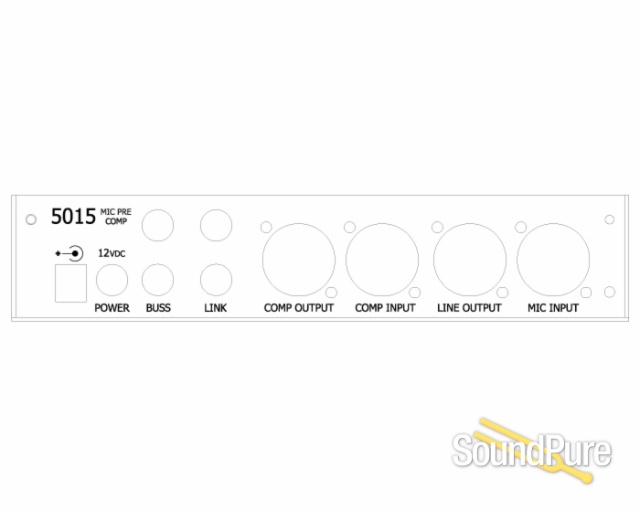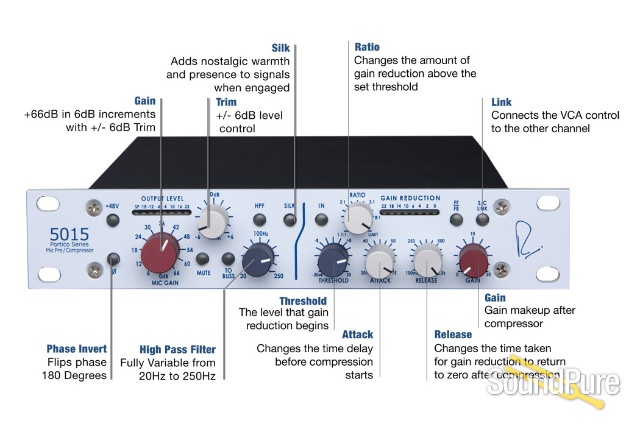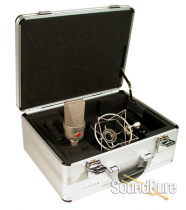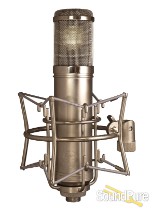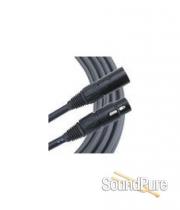With independent transformer-coupled mic preamp and compressor-limiter sections identical to those found in the 5012 and 5043 modules, the fully analogue Portico 5015 combines the outstanding sound quality expected from a Rupert Neve design with the total flexibility required by modern recording studios. Available in both Vertical and horizontal configurations, when used with the 5033 five band EQ it is possible to create a Portico channel strip with preamplification, dynamics processing and equalization. As an additional routing option, the mic pre output may be routed directly to the compressor section without patching by pressing the To Compressor switch.
MICROPHONE Preamplifier
The microphone input is balanced but not floating, being a variant of an instrumentation amplifer using a Transformer-Like-Amplifier (T.L.A.) configuration with a toroidal Common Mode Rejection Low Pass Filter that excludes frequencies above 150 kHz. The T.L.A. is followed by an actual input transformer designed by Mr. Neve that permits a full +25 dBu input signal to be handled at unity gain without an input pad over the whole audio spectrum. This innovative solution combines the advantages of both an Electronically Balanced and true transformer input.
In addition to the 72 dB of gain, the 5015 mic pre includes individually selectable phase, mute, phantom power, a swept high pass filter from 20-250 Hz, and the Silk circuit which yields the rich warmth and presence of the renowned classic designs.
The Compressor Section
The 5015’s compressor has fully variable threshold, ratio, attack, release and makeup gain with two selectable VCA modes that provide for exceptional control of any source material. How it Works
In order to control gain, a V.C.A. or Voltage Controlled Amplifier (or Attenuator) is used. There are many types of V.C. including the use of tubes, discrete and integrated solid state circuits and naturally non-linear devices, each one having its characteristic behavior that reflects sonically on the final performance, and gives it a character or signature that can be musically attractive or not! The Portico 5043 makes use of a very accurate, low noise, low distortion V.C.A. having, essentially, no signature of its own.
A part of the audio signal is rectified and smoothed to produce a suitable control voltage for the V.C.A. which has to respond very quickly and have low distortion. If the response is too fast, low frequency signals will themselves, be gain controlled! If the response is too slow, the signal will overshoot and the first few cycles will not get compressed. The speed and accuracy of the response, known as the attack, and the time frame that gain remains under the initial control, known as release or recovery and plays a large part in the way a compressor sounds.
All Portico modules use input and output transformers and, almost entirely discrete component amplifiers. In fact the Line amplifiers on their own, inserted into the signal chain, are capable of enhancing the sonic quality of many signal sources, especially those of digital origin. These are some of the factors that enable, the Portico 5043, to work so unobtrusively within the context of a very high quality audio chain.
Feed Forward or Feed Back?
The Portico 5043 provides a choice of feed-forward or feed-back compression modes. The FB Button allows the user to switch between the two modes.
If the V.C.A. Control voltage is taken from the 5043 input, (i.e. before the V.C.A.) the V.C.A. knows right away that a gain change is required and there is almost immediate response. This is known, logically, as a “Feed-Forward” compressor.
If the V.C.A. Control voltage is taken from the 5043 output, (i.e. after the V.C.A.) it cannot act immediately on the V.C.A. because it has already been modified by settings of the V.C.A. and circuits through which it has passed. This is known as a “Feed-Back” compressor. The two compression characteristics are quite different; there is more “Overshoot” and both the attack and recovery ramps are changed, providing the user with powerful choices. Almost all of Neve’s earlier designs were “Feed-Back.” They were more musical and sweeter than with “Feed-Forward” designs; however the “Feed-Forward” design provides greater accuracy.
Ratio and Threshold
Above a given THRESHOLD signals are reduced by an adjustable amount ranging from 1:1, (which is linear, or no reduction at all), to more than 40:1 which is a very high ratio, equivalent to that of a Limiter. RATIO is sometimes referred to as Slope because when depicted on a graph, the slope of the graph representing Output versus Input, is what changes.
Ratio and Threshold are closely inter-dependent. If a RATIO as high as 40:1 has been set, then if the THRESHOLD is set at 0 dBu, even when a massive signal of +40 dBu (unlikely!) is presented to the input, the output signal will only be +1 dBu. RATIOS as high as this would normally be set somewhere above 0 dBu – say at +14 dBu, in order to prevent the output signal level exceeding just over +14 dBu to protect, for example, a digital recorder. Similarly, if a RATIO of 5:1 has been set, an input signal which is 10dB above THRESHOLD will only rise by 2dB above that THRESHOLD at the output.
THRESHOLD control covers the Range from below -30dB to +22dBu. When THRESHOLD set at a low level, with a fairly high RATIO the amount of gain reduction will be considerable and it may be necessary to use some GAIN after the compressor to restore the apparent signal level.
Attack Time
The ATTACK time is the time taken for the compression circuits to start compressing. A long ATTACK time allows short duration peaks to escape and go through uncompressed. This may cause overload on subsequent digital circuits. A very short attack time sounds un-natural and robs the signal of life by removing transients. Some transients are extremely fast and have little effect on the sound quality. Setting a long attack time often means that almost no gain reduction occurs because the transient is history (!) before compression has had time to operate. However, even the fastest circuits take time to operate which means that there is always some Overshoot. Small amounts of Overshoot are musically desirable – there are exceptions, of course.
Setting the right values of RELEASE and ATTACK is what compression is all about! Once the principles are understood a Compressor-Limiter such as the 5043 provides a powerful tool that actually appears to enhance the dynamic range of a recording and so provide greater musical enjoyment.
Release / Recovery
The notes above explain how the 5043 handles signals of constant amplitude such as pure tones. Real program signals, however, are continually changing in level. The way in which a compressor deals with actual program material depends upon the magnitude and duration of peaks in the program level. If the RELEASE TIME is set to be very short, a short duration signal will be compressed but the gain will return to normal very quickly, giving a fluctuating and un-natural sound known as Pumping when the background, or other signals, are forced up and down. The gain will also tend to follow the wave form of low frequency signals. RELEASE TIME should be set long enough for the gain to remain reasonably constant between each bass note or between speech syllables.
Why Transformers
The fine subtleties of circuit design relating to sonic performance are gradually becoming more clearly understood. For example, research has shown conclusively that frequencies above 20 kHz affect the way in which humans perceive sound quality. But, long before scientific evidence emerged a substantial body of musicians and engineers knew that equipment with apparently the same technical measurements could sound very different.
Incredibly small amounts of musically dissonant odd harmonics have a disastrous effect on the sound quality. Extraneous noise or interference that finds its way into a signal path seriously impairs performance of the whole chain. Since many control rooms make use of outboard gear that is not well protected from external signals. Poor grounding of such equipment can be a serious problem. “Electronically balanced” circuits much used in modern equipment, can give very good measurements on the test bench but they do not provide adequate rejection of the stray fields found in every working environment.
To correct these issues, input and output circuits must be freed from ground dependence so that only the wanted signal enters and leaves the processing path. Transformers are the ideal solution. The sweet and silky sound of Mr. Neve’s classic designs was achieved with big transistors and large high quality transformers. Rupert Neve Designs Portico modules achieve similar quality today without the bulk or the cost.
In order that modules can work together as would be expected (i.e. in a proprietary console configuration) without producing hum, R.F. interference, or other interactions, the connecting interfaces, grounding, levels and impedances must receive careful attention. Each Portico module is a complete integral signal processor that delivers its specified performance independently. This is why we use transformers.
Low Noise, Low Distortion Operation
Much care was given in designing the 5015 to produce as little noise and non-harmonic distortion as possible. Carefully implemented signal paths and Class A operation are a large part of the 5015′s sweet, whisper quiet performance. For more information, go to Mr. Rupert Neve’s Design Notes.













